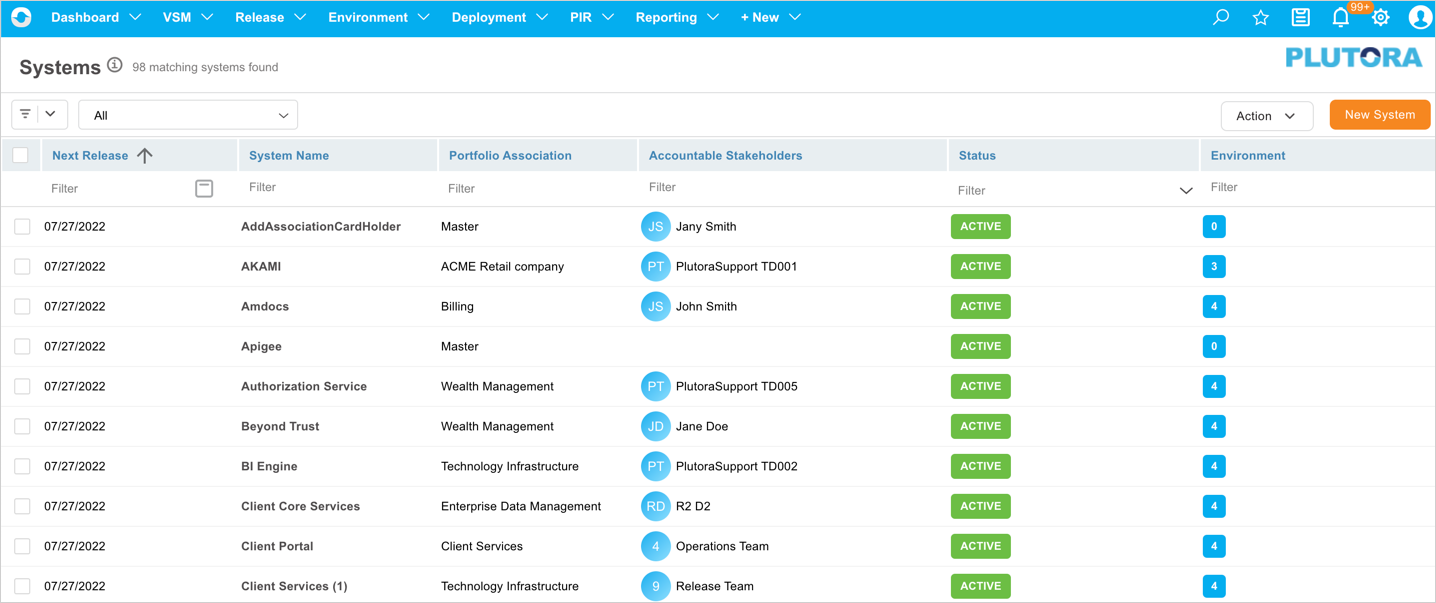Introduction
Systems in Plutora represent the applications and microservices that your organization is responsible for in terms of ongoing development and operational support. This may also include third party vendor applications that you use internally or as part of the services you provide for your customers. Capturing the details of all your Applications and Microservices is critical first step when onboarding to Plutora.
It is mandatory for implementing the Environment Management module as System selection is a mandatory field on all Environments within Plutora.
It is a critical for Release and Deployment Manager modules so you start tracking exactly which Applications and Microservices are going to be impacted as part of a Release each month.
Systems and Subsystems
There are two types of Systems in Plutora
- Systems – Are used to represent Applications and stand alone services or they can be use to represent business domains used to group microservices
- Subsystems – Are used to represent the microservices/components that an Application or business domain is made up of
Default Grid Views Customization allows administrators to align the grid view setup for new users or for all users.
Pre-requisite
Navigation
Environment > Systems
System Grid Layout and Features
On the Systems page, you can:
- View, search, and filter Systems
- Add and edit Systems
- Duplicate Systems
- Bulk update Systems
- Delete Systems
- Export Systems To XLS
Search and Filter Options
My Filter
- My Portfolio Association: Show Systems for your Portfolio Association. Check which Portfolio Association you belong to in Settings.
- I’m a Stakeholder: Show Systems for which you are a Stakeholder.
- All: Show all Systems.
Grid Column Filter
The grid column filter is the set of search fields and menus at the top of the data columns, under the column headers.
To filter using the Grid Column,
- Search field: Type a search term.
- Drop-down menu: Click to select a list item.
- Combo box: Click to select one or more checkboxes.
- Date field: Select a date and click OK.
Press the Enter key to run the filter. To clear the filter, click X next to the filter value.
Use Query Builder
Query Builder allows you to create and save your own private searches and use public searches.
You must have the ‘Create/Delete Public Query Builder’ user permissions to create, edit or delete public queries.
To use Query Builder, click ![]() on the Systems page. See Query Builder for more information. Clicking
on the Systems page. See Query Builder for more information. Clicking![]() opens the quick access menu, which lists private and public queries.
opens the quick access menu, which lists private and public queries.
Show/Hide Columns
The ‘Systems’ grid has a number of default columns, you can show or hide these columns using the ‘Show/Hide’ feature.
- Click
 .
. - Select Show/Hide Columns.
- The ‘Systems Columns’ pop-up displays. Check/uncheck the columns that you want to show/hide respectively.
- Click
 .
.
Export Systems to XLS
You can export only those Systems that are available on the grid. Filter your Systems using the above options to alter the data to export.
To export to XLS, click![]() and then click Export to XLS.
and then click Export to XLS.
Your excel file should start downloading immediately. If it doesn’t, check your pop-up blocker settings. Save the file to your hard drive if prompted.
More Information
Show User Groups
Hover your mouse cursor over a user group in the ‘Accountable Stakeholders’ column to show the group members.






